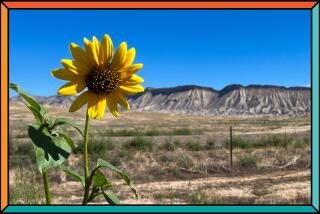Some Southland Plants of Monumental Importance
I’ve never been able to resist those signs that say “Historic Landmark, 6 miles.” At the end of some of these side trips, I’ve even found plants of landmark stature.
Plants, as well as buildings and campsites where Portola or Father Serra spent the night, are eligible for historic landmark status. Somebody simply has to nominate them.
For plants in the Los Angeles area, you can do this quite simply by writing to the Cultural Affairs Department, Room 1500, City Hall, Los Angeles 90012. This also is the address to write to if you want a listing of those plants and places that have already become landmarks, described in the Cultural Heritage Commission’s Historic-Cultural Monuments booklet (a donation is requested).
Plants were among the first things saved (though one fell in the battle) when Monument No. 1, the Leonis Adobe in Woodland Hills, was under attack by a bulldozer in 1962. The dwelling was saved when it was declared a monument, and all of the old live oaks that surround the adobe were saved except one.
Oaks are the most numerous landmark plants in California. No. 24 on Louise Avenue, 210 feet south of Ventura Boulevard, in Encino, is a coast live oak judged to be more than 1,000 years old. No. 38 wasn’t so lucky. It is now listed as “(Site of) Founder’s Oak.” It was where Pacific Palisades was founded, but the tree was lost to termites in 1975. As I recall, it wasn’t a big oak, and a new one has taken its place.
Several other big or old plants also are city monuments. No. 19 is one of my favorites because it is right down the street, a huge, sprawling Moreton Bay fig, like the one that is a state landmark in Santa Barbara, just off U.S. 101. (The latter fig is now a home for the homeless, who sleep nestled in its huge above-ground roots.) The Ficus macrophylla near me, on National Boulevard near Military Avenue in West Los Angeles, was planted in 1875.
Avenue plantings have also made monument status--the 144 deodar trees on White Oak Avenue in Granada Hills, planted in 1932; the 76 olive trees on Lassen Street in Chatsworth, planted late in the 19th Century; the cedars on Los Feliz Boulevard, planted in 1916; the palms on Highland Avenue, planted in 1928; and the beautiful if somewhat fragile coral trees on San Vicente Boulevard (the oldest of these actually grows at the Santa Monica end of this thoroughfare).
The prettiest of the avenue plantings probably are the pepper trees that cover Canoga Avenue in Woodland Hills, but I think there are many more street trees deserving of landmark status, if someone will just nominate them.
Plants also are California State Landmarks, though nominating one for this status is more difficult. In fact, the directory of landmarks is out of print and under revision, but you can buy a book that lists them, along with helpful maps, called “Discover Historic California” by George and Jan Roberts (Gem Guides Book Co.: $9.95).
This is where you’ll find the Santa Barbara Moreton Bay fig, and the information that “this massive tree could provide shade for 10,000 people standing under its branches.”
One I haven’t seen yet is the old sycamore tree (State Historic Landmark 756) in Santa Paula where Gen. John C. Fremont camped. I also haven’t seen the Whittier walnut tree (No. 681), planted in the early 1900s; or the first navel orange tree in California (No. 20), on the corner of Magnolia and Arlington avenues in Riverside.
The Glendora bougainvillea (No. 912) is described on the commemorating brass plaque as being “the largest growth” in the country, though I’m not quite sure what this means. I followed the sign to this planting just last week and found two blocks lined with palms, each with a bougainvillea planted at its base. The trunks on the bougainvillea rival those of the palms in size, but the leafy part isn’t very big.
They appear to have been pruned recently, probably so some huge steel cages could be constructed for them to climb in, and they now surround a new townhouse development called Rancho del Bougainvillea. I suspect that their landmark status saved them when the property was developed; this points out the importance of getting landmark status, or monument status, for plants.
I hope this status will keep more landmark plants from the “site of” category. How I would like to have seen the Serra palms in San Diego, now the Site of Serra Palm (State Historic Landmark 67), where Father Serra and Gaspar de Portola began their exploration of California and planted the first date palms in California.
If you have a candidate in mind, and don’t know where to send your recommendation, I’ll forward it to the proper authorities, and maybe mention your suggestion in this column so others can enjoy it as well.
Robert Smaus, You Section, The Times, Times Mirror Square, Los Angeles 90053. (Do not phone.)






